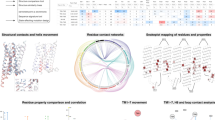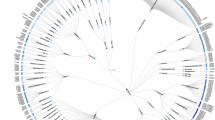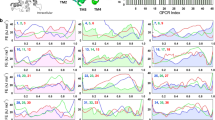Abstract
G protein-coupled receptors (GPCRs) are targeted by ∼30–40% of marketed drugs, and their key roles in normal physiology and in disease demonstrate that an understanding of their structure and function is valuable to researchers in both basic science and drug discovery. However, until recently, detailed structural information on this protein family was limited by challenges in X-ray crystallographic analysis of such membrane proteins. The GPCR Network was created in 2010 with the goal of structurally characterizing 15–25 representative human GPCRs within 5 years, based on an active outreach programme addressing an interdisciplinary community of scientists interested in GPCR structure, chemistry and biology. Here, we provide an overview of how this collaborative effort has enabled the structural determination and characterization of eight human GPCRs so far, and discuss some of the challenges that remain in gaining more detailed insights into structure–function relationships in this receptor superfamily.
This is a preview of subscription content, access via your institution
Access options
Subscribe to this journal
Receive 12 print issues and online access
$209.00 per year
only $17.42 per issue
Buy this article
- Purchase on Springer Link
- Instant access to full article PDF
Prices may be subject to local taxes which are calculated during checkout




Similar content being viewed by others
References
Rajagopal, S., Rajagopal, K. & Lefkowitz, R. J. Teaching old receptors new tricks: biasing seven-transmembrane receptors. Nature Rev. Drug Discov. 9, 373–386 (2010).
Wise, A., Gearing, K. & Rees, S. Target validation of G-protein coupled receptors. Drug Discov. Today 7, 235–246 (2002).
Kobilka, B. K. & Deupi, X. Conformational complexity of G-protein-coupled receptors. Trends Pharmacol. Sci. 28, 397–406 (2007).
Cherezov, V. et al. High-resolution crystal structure of an engineered human β2-adrenergic G protein-coupled receptor. Science 318, 1258–1265 (2007).
Jaakola, V. P. et al. The 2.6 angstrom crystal structure of a human A2A adenosine receptor bound to an antagonist. Science 322, 1211–1217 (2008).
Weigelt, J., McBroom-Cerajewski, L. D., Schapira, M., Zhao, Y. & Arrowsmith, C. H. Structural genomics and drug discovery: all in the family. Curr. Opin. Chem. Biol. 12, 32–39 (2008).
Mileni, M. et al. Structure-guided inhibitor design for human FAAH by interspecies active site conversion. Proc. Natl Acad. Sci. USA 105, 12820–12824 (2008).
Oksenberg, D. et al. A single amino-acid difference confers major pharmacological variation between human and rodent 5-HT1B receptors. Nature 360, 161–163 (1992).
Tucker, A. L. et al. A1 adenosine receptors. Two amino acids are responsible for species differences in ligand recognition. J. Biol. Chem. 269, 27900–27906 (1994).
Yao, B. B. et al. Molecular modeling and pharmacological analysis of species-related histamine H3 receptor heterogeneity. Neuropharmacology 44, 773–786 (2003).
Valant, C., Robert Lane, J., Sexton, P. M. & Christopoulos, A. The best of both worlds? Bitopic orthosteric/allosteric ligands of G protein-coupled receptors. Annu. Rev. Pharmacol. Toxicol. 52, 153–178 (2012).
Reynolds, K., Abagyan, R. & Katritch, V. in GPCR Molecular Pharmacology and Drug Targeting: Shifting Paradigms and New Directions (ed. Gilchrist, A. ) 385–433 (Wiley & Sons, 2010).
Yarnitzky, T., Levit, A. & Niv, M. Y. Homology modeling of G-protein-coupled receptors with X-ray structures on the rise. Curr. Opin. Drug Discov. Devel. 13, 317–325 (2010).
Cavasotto, C. N. & Phatak, S. S. Homology modeling in drug discovery: current trends and applications. Drug Discov. Today 14, 676–683 (2009).
Michino, M. et al. Community-wide assessment of GPCR structure modelling and ligand docking: GPCR Dock 2008. Nature Rev. Drug Discov. 8, 455–463 (2009).
Kufareva, I., Rueda, M., Katritch, V., Stevens, R. C. & Abagyan, R. Status of GPCR modeling and docking as reflected by community-wide GPCR Dock 2010 assessment. Structure 19, 1108–1126 (2011).
Thompson, A. A. et al. Structure of the nociceptin/orphanin FQ receptor in complex with a peptide mimetic. Nature 485, 395–399 (2012).
Xu, F. et al. Structure of an agonist-bound human A2A adenosine receptor. Science 332, 322–327 (2011).
Jaakola, V. P. et al. Ligand binding and subtype selectivity of the human A2A adenosine receptor: identification and characterization of essential amino acid residues. J. Biol. Chem. 285, 13032–13044 (2010).
Deflorian, F. et al. Evaluation of molecular modeling of agonist binding in light of the crystallographic structure of an agonist-bound A2A adenosine receptor. J. Med. Chem. 55, 538–552 (2012).
Tosh, D. K. et al. Optimization of adenosine 5′-carboxamide derivatives as adenosine receptor agonists using structure-based ligand design and fragment screening. J. Med. Chem. 55, 4297–4308 (2012).
Wu, H. et al. Structure of the human κ-opioid receptor in complex with JDTic. Nature 485, 327–332 (2012).
Wu, B. et al. Structures of the CXCR4 chemokine GPCR with small-molecule and cyclic peptide antagonists. Science 330, 1066–1071 (2010).
Chien, E. Y. et al. Structure of the human dopamine D3 receptor in complex with a D2/D3 selective antagonist. Science 330, 1091–1095 (2010).
Shimamura, T. et al. Structure of the human histamine H1 receptor complex with doxepin. Nature 475, 65–70 (2011).
Hanson, M. A. et al. Crystal structure of a lipid G protein-coupled receptor. Science 335, 851–855 (2012).
West, G. M. et al. Ligand-dependent perturbation of the conformational ensemble for the GPCR β2 adrenergic receptor revealed by HDX. Structure 19, 1424–1432 (2011).
Palczewski, K. et al. Crystal structure of rhodopsin: a G protein-coupled receptor. Science 289, 739–745 (2000).
Murakami, M. & Kouyama, T. Crystal structure of squid rhodopsin. Nature 453, 363–367 (2008).
Warne, T. et al. Structure of a β1-adrenergic G-protein-coupled receptor. Nature 454, 486–491 (2008).
Haga, K. et al. Structure of the human M2 muscarinic acetylcholine receptor bound to an antagonist. Nature 482, 547–551 (2012).
Kruse, A. C. et al. Structure and dynamics of the M3 muscarinic acetylcholine receptor. Nature 482, 552–556 (2012).
Manglik, A. et al. Crystal structure of the μ-opioid receptor bound to a morphinan antagonist. Nature 485, 321–326 (2012).
Granier, S. et al. Structure of the δ opioid receptor bound to naltrindole. Nature 485, 400–404 (2012).
White, J. F. et al. Structure of the agonist-bound neurotensin receptor. Nature 490, 508–513 (2012).
Standfuss, J. et al. The structural basis of agonist-induced activation in constitutively active rhodopsin. Nature 471, 656–660 (2011).
Scheerer, P. et al. Crystal structure of opsin in its G-protein-interacting conformation. Nature 455, 497–502 (2008).
Rosenbaum, D. M. et al. GPCR engineering yields high-resolution structural insights into β2-adrenergic receptor function. Science 318, 1266–1273 (2007).
Rasmussen, S. G. et al. Structure of a nanobody-stabilized active state of the β2 adrenoceptor. Nature 469, 175–180 (2011).
Hanson, M. A. et al. A specific cholesterol binding site is established by the 2.8 Å structure of the human β2-adrenergic receptor. Structure 16, 897–905 (2008).
Wacker, D. et al. Conserved binding mode of human β2 adrenergic receptor inverse agonists and antagonist revealed by X-ray crystallography. J. Am. Chem. Soc. 132, 11443–11445 (2010).
Lebon, G. et al. Agonist-bound adenosine A2A receptor structures reveal common features of GPCR activation. Nature 474, 521–525 (2011).
Dore, A. S. et al. Structure of the adenosine A2A receptor in complex with ZM241385 and the xanthines XAC and caffeine. Structure 19, 1283–1293 (2011).
Rasmussen, S. G. et al. Crystal structure of the β2 adrenergic receptor–Gs protein complex. Nature 477, 549–555 (2011).
Katritch, V., Cherezov, V. & Stevens, R. C. Diversity and modularity of G protein-coupled receptor structures. Trends Pharmacol. Sci. 33, 17–27 (2012).
Liu, J. J., Horst, R., Katritch, V., Stevens, R. C. & Wuthrich, K. Biased signaling pathways in β2-adrenergic receptor characterized by 19F-NMR. Science 335, 1106–1110 (2012).
Johnston, J. M. & Filizola, M. Showcasing modern molecular dynamics simulations of membrane proteins through G protein-coupled receptors. Curr. Opin. Struct. Biol. 21, 552–558 (2011).
Carlsson, J. et al. Structure-based discovery of A2A adenosine receptor ligands. J. Med. Chem. 53, 3748–3755 (2010).
Katritch, V. et al. Structure-based discovery of novel chemotypes for adenosine A2A receptor antagonists. J. Med. Chem. 53, 1799–1809 (2010).
Mysinger, M. M. et al. Structure-based ligand discovery for the protein–protein interface of chemokine receptor CXCR4. Proc. Natl Acad. Sci. USA 109, 5517–5522 (2012).
Carlsson, J. et al. Ligand discovery from a dopamine D3 receptor homology model and crystal structure. Nature Chem. Biol. 7, 769–778 (2011).
de Graaf, C. et al. Crystal structure-based virtual screening for fragment-like ligands of the human histamine H1 receptor. J. Med. Chem. 54, 8195–8206 (2011).
Congreve, M., Langmead, C. & Marshall, F. H. The use of GPCR structures in drug design. Adv. Pharmacol. 62, 1–36 (2011).
Shoichet, B. K. & Kobilka, B. K. Structure-based drug screening for G-protein-coupled receptors. Trends Pharmacol. Sci. 33, 268–272 (2012).
Roth, C. B., Hanson, M. A. & Stevens, R. C. Stabilization of the human beta2-adrenergic receptor TM4–TM3–TM5 helix interface by mutagenesis of Glu122(3.41), a critical residue in GPCR structure. J. Mol. Biol. 376, 1305–1319 (2008).
Xu, F., Liu, W., Hanson, M. A., Stevens, R. C. & Cherezov, V. Development of an automated high throughput LCP-FRAP assay to guide membrane protein crystallization in lipid mesophases. Cryst. Growth Des. 11, 1193–1201 (2011).
Caffrey, M. & Cherezov, V. Crystallizing membrane proteins using lipidic mesophases. Nature Protoc. 4, 706–731 (2009).
Fredriksson, R., Lagerstrom, M. C., Lundin, L. G. & Schioth, H. B. The G-protein-coupled receptors in the human genome form five main families. Phylogenetic analysis, paralogon groups, and fingerprints. Mol. Pharmacol. 63, 1256–1272 (2003).
Katritch, V. et al. Analysis of full and partial agonists binding to β2-adrenergic receptor suggests a role of transmembrane helix V in agonist-specific conformational changes. J. Mol. Recognit. 22, 307–318 (2009).
Katritch, V., Kufareva, I. & Abagyan, R. Structure based prediction of subtype-selectivity for adenosine receptor antagonists. Neuropharmacology 60, 108–115 (2011).
Liu, W. et al. Structural basis for allosteric regulation of GPCRs by sodium ions. Science 337, 232–236 (2012).
Acknowledgements
The GPCR Network acknowledges support from the US National Institutes of Health (NIH)/National Institute of General Medical Sciences (NIGMS) PSI:Biology grant U54 GM094618 and the NIH Common Fund grant P50 GM073197 to the Joint Center for Innovative Membrane Protein Technologies (JCIMPT) for technology development. The authors are grateful to the members of the Scientific Advisory Board (T. W. Schwarz, B. L. Roth, R. M. Stroud, G. Wagner, S. H. White and I. A. Wilson) and community collaborators, including A. Brooun, G. Calo. R. Guerrini, T. Handel, M. Hanson, A. IJzerman, S. Iwata, K. Jacobson, J. Javitch, T. Kobayashi, B. Kobilka, P. D. Mosier, A. H. Newman, B. L. Roth, L. Shi and P. Wells. The authors thank K. Kadyshevskaya and I. Kufareva for assistance with figure preparation, and E. Abola and A. Walker for assistance with manuscript preparation.
Author information
Authors and Affiliations
Corresponding author
Ethics declarations
Competing interests
R.C.S. is a founder, and H.R. is a founder and on the scientific advisory board, of Receptos, a GPCR structure-based drug discovery company. All other authors declare no competing financial interests.
Related links
Glossary
- Allosteric ligands
-
Ligands that bind elsewhere from the orthosteric binding site and influence the functional properties of the receptor. In some classifications, the intracellular binding partners (for example, G proteins) are considered to be allosteric molecules as they bind at a distance of 30 Å from the orthosteric ligand-binding site.
- Bitopic ligands
-
Ligands that have both orthosteric ligand-binding properties as well as a secondary element that is able to bind to a neighbouring allosteric site on the receptor.
- Cα atoms
-
The chiral carbon atoms to which the primary amine, the carboxylic group and the side chain are attached to in an amino acid. Comparison of three-dimensional structures of proteins is sometimes carried out by superimposing the Cα atoms of proteins, as this provides a simple estimate of the similarity of their skeleton or backbone structure.
- Electron paramagnetic resonance
-
(EPR). Similar in concept to NMR spectroscopy, but whereas NMR examines the spins of atomic nuclei, EPR detects the spins of unpaired electrons.
- Hydrogen–deuterium exchange mass spectroscopy
-
(HDX-MS). A technique used to probe protein conformations. The exchange rate of an amide hydrogen is substantially influenced by hydrogen bonding, and the exchange kinetics of an amide hydrogen can be highly reflective of its locations in secondary and tertiary structures.
- Non-olfactory receptors
-
G protein-coupled receptors from the Rhodopsin family, excluding the ∼388 olfactory receptors.
- Orthosteric ligands
-
Ligands that bind to the natural ligand-binding site on the receptor and thus directly compete with this natural ligand for receptor binding. For class A G protein-coupled receptors (GPCRs), the orthosteric binding site is typically in the cavity positioned in the extracellular portion of the seven-transmembrane region. For class B and class C GPCRs, pockets in this location are considered to be allosteric because their natural ligands bind in a separate extracellular domain.
- Root mean square deviation
-
(RMSD). A quantitative measure of the similarity between two superimposed sets of atomic coordinates. RMSD values (units of Å) can be calculated for any type and subset of atoms: for example, for chiral carbon (Cα) atoms of proteins (Cα RMSD) for all residues; for residues in the transmembrane helices or the loops; as well as for non-hydrogen atoms of small-molecule ligands (ligand RMSD).
Rights and permissions
About this article
Cite this article
Stevens, R., Cherezov, V., Katritch, V. et al. The GPCR Network: a large-scale collaboration to determine human GPCR structure and function. Nat Rev Drug Discov 12, 25–34 (2013). https://doi.org/10.1038/nrd3859
Published:
Issue Date:
DOI: https://doi.org/10.1038/nrd3859
This article is cited by
-
19F-NMR studies of the impact of different detergents and nanodiscs on the A2A adenosine receptor
Journal of Biomolecular NMR (2024)
-
GPR37 promotes colorectal cancer liver metastases by enhancing the glycolysis and histone lactylation via Hippo pathway
Oncogene (2023)
-
The dual roles of autophagy and the GPCRs-mediating autophagy signaling pathway after cerebral ischemic stroke
Molecular Brain (2022)
-
A machine learning model for classifying G-protein-coupled receptors as agonists or antagonists
BMC Bioinformatics (2022)
-
Chimeric GPCRs mimic distinct signaling pathways and modulate microglia responses
Nature Communications (2022)



